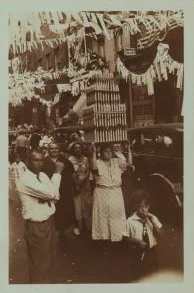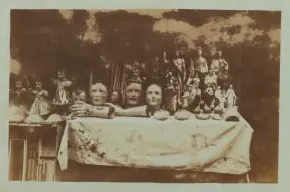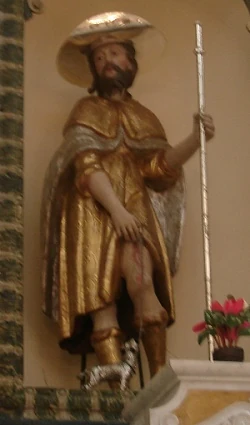




The Society is determined to see Saint Rocco's Feast not only experience a renaissance in terms of attendance, but to see that all of the ancient Southern Italian traditions be followed and preserved to be passed down to future generations. Remarkably, the procession has not deviated in any material way from the original held in Potenza, Basilicata, Italy so many years ago and those held on New York's Lower East Side at the beginning of the last century.
Recently, "u cinte," or more commonly known among Italian Americans as the "candlehouse or candelabra," is carried for the entire procession in front of Saint Rocco's statue. It is composed of over 200 candles arranged in a multi-tiered wooden frame decorated with ribbons and flowers and topped with a small image of the Saint. The candlehouses are carried in front of the Saint's statue either on top of the devotee's head or with the larger versions, carried by two or more people. Saint Rocco's "candlehouse" was designed and constructed by Salvatore La Rocca, the Society president's father. Salvatore La Rocca spent the entire month of July 2003 and much of August designing, constructing, painting, and decorating the candlehouse. A fitting tribute to Saint Rocco on his Feast day.
For the first time in over 25 years, "voti di cera," or "vows of wax" were again carried during the procession on August 20, 2006. The "voti di cera" are wax representations of various body parts which devotees believe were cured through the intercession of a saint. The vows of wax remain very popular forms of demonstrating thanksgiving to a saint throughout Southern Italy. As Saint Rocco is among other things the patron Saint of the sick, it was logical that devotees marching with the wax representations would play an important role in his procession. In conversations with older Italian Americans who experienced Saint Rocco's procession during the 30s, 40s, and 50s, the "wax body parts always played a role in their fond memories." Unfortunately, approximately 20 years ago, a priest formerly at Saint Joseph's Church determined that the wax vows were "archaic" and "pagan" and destroyed them. Mr. LaRocca in his never-ending mission to restore every element of the Feast searched for a way to obtain replacements. His search ended when Joseph Rigitano, a society member returned to his hometown in Calabria, where he was able to obtain new wax models and bring them back to New York. These wax vows were carried in the 2006 procession and continue to be carried in the processions.


Saint Rocco's fame comes in large part as a healer par excellence, patron saint of the sick. He is tremendously popular in the Basilicata region of Southern Italy, also once known as Lucania. It is estimated that he is the patron Saint of approximately eighty percent of the towns in the region and in those towns of Basilicata where he is not the patron Saint of the town, there always exists a strong devotion to him and yearly procession. His reputation as an overall miracle worker made him greatly loved throughout Southern Italy and Sicily. Feasts are held in his honor throughout Southern Italy and Sicily during the month of his Feast day.
Each year's Feast draws Italian Americans from New York City's five boroughs, Long Island, and New Jersey. In addition, there are devotees from Massachusetts, Connecticut, Canada, and even Italian Australians visiting relatives in New York City. Whether they come from literally across the street or far away, they all bring their enthusiasm, love, and devotion to this annual event.
The astounding level of interest shown by the Italian American community in this event is profoundly moving. These are people who genuinely believe in Saint Rocco and want to publicly demonstrate that love and belief in true Southern Italian style.